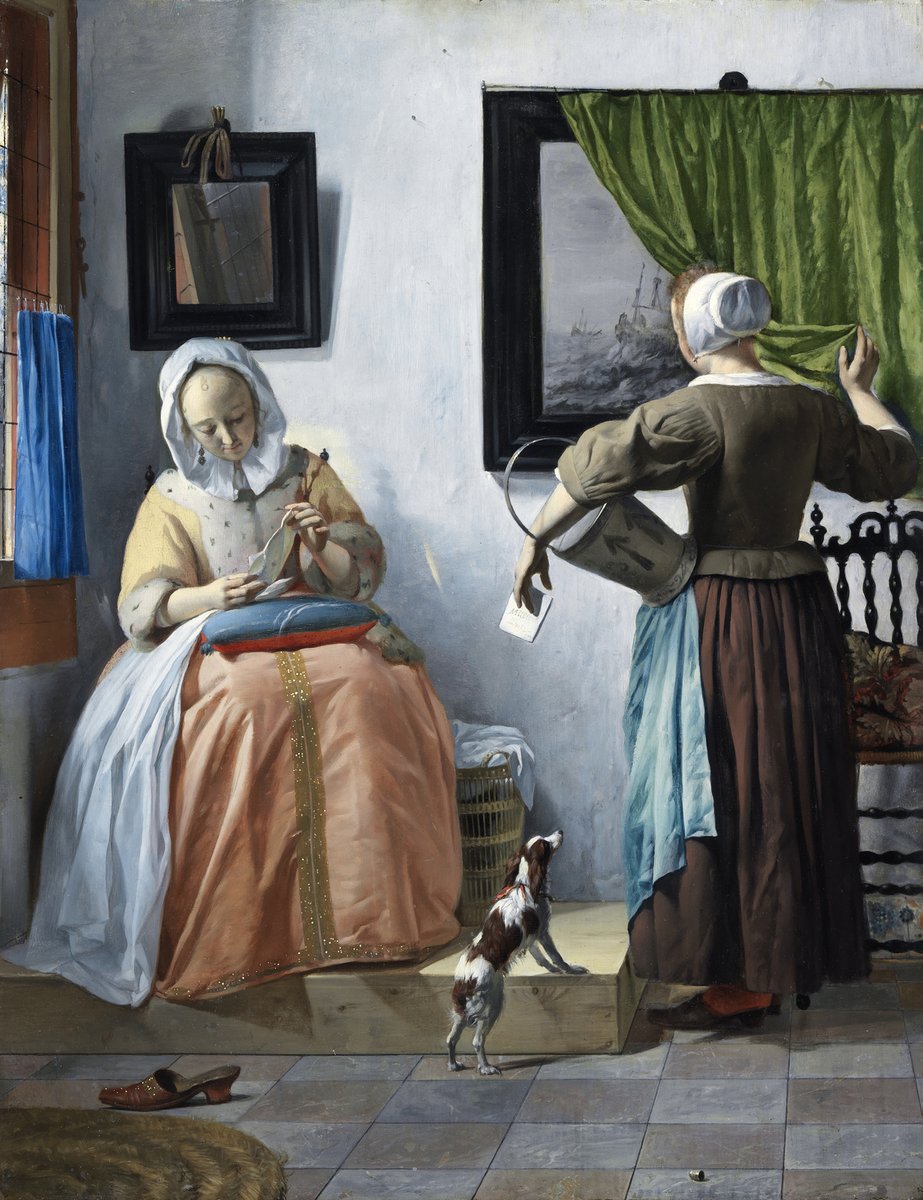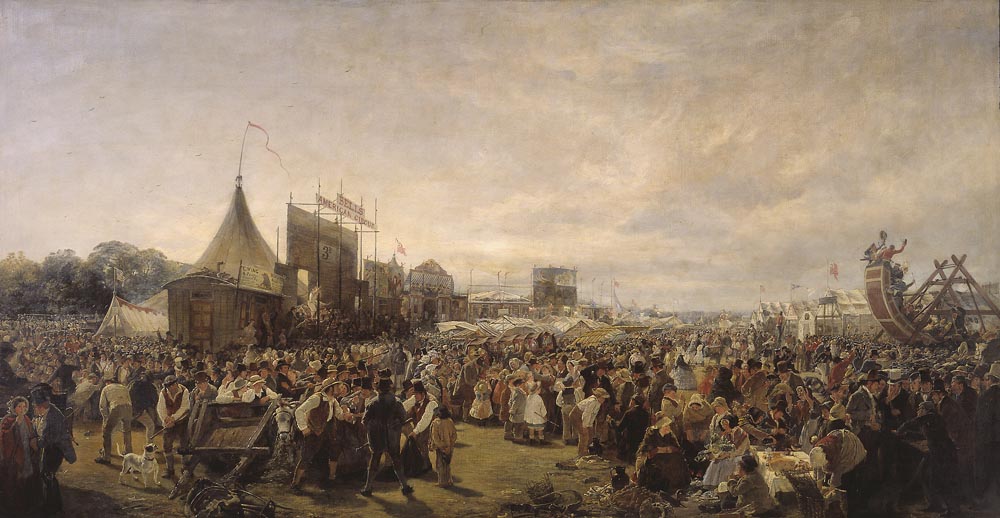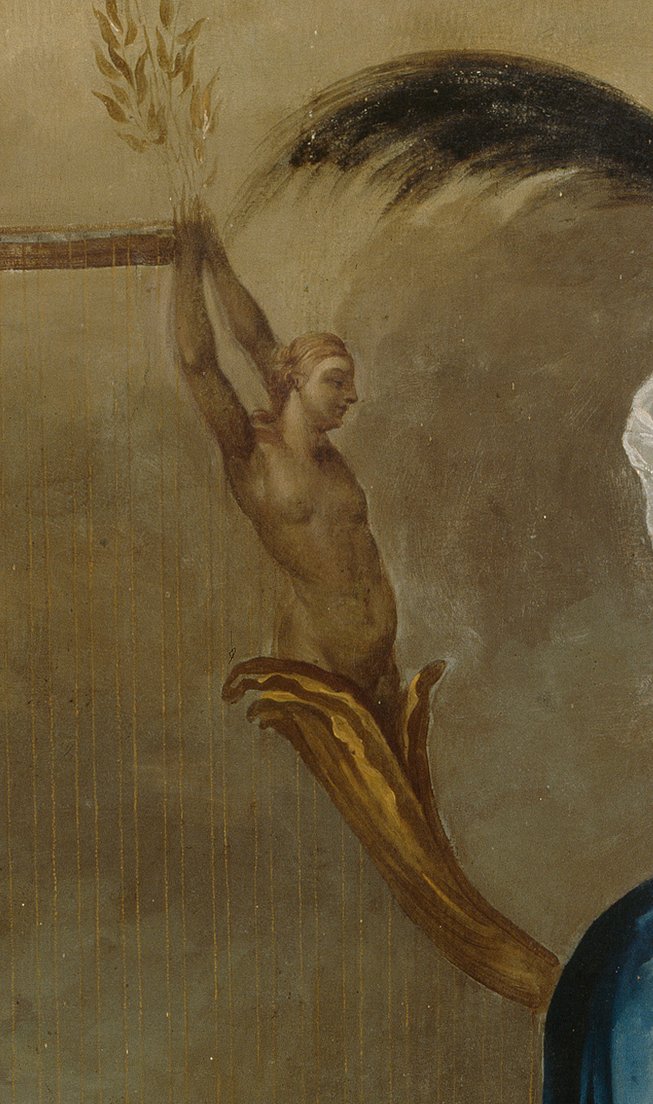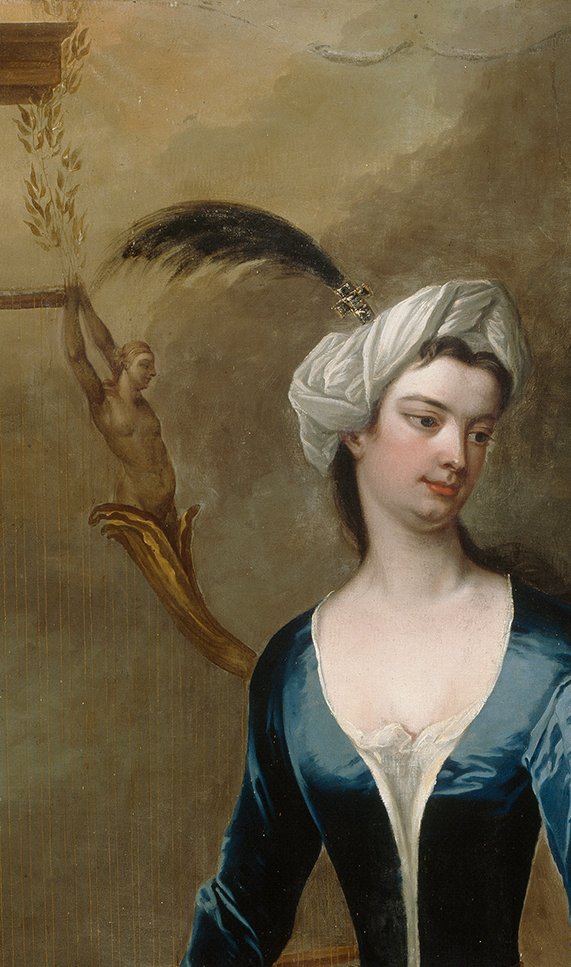Today we& #39;re going to be looking at some & #39;Easter Eggs& #39; in our collection. Not of the chocolate variety, but secrets and clues hidden in paintings - artists hiding in plain sight, secrets uncovered by conservation work, clues planted to given extra meaning, and more!
First up, and today& #39;s Work of the Day, is Metsu& #39;s Woman Reading a Letter (1664-66) which the artist has filled with hidden signs and details.
#NationalGalleryIRL #ArtEasterEggs
#NationalGalleryIRL #ArtEasterEggs
When looked at in tandem with its companion piece (which hangs beside it at the National Gallery of Ireland) we can assume that the woman is reading a love letter from this man, which she is attempting to hide from her maid, turning it away from her.
Metsu has added a clue to show us that the maid is well aware of who the letter is from, and has a warning for the lovers - she pulls back a curtain showing a painting of a ship on choppy waters, a reference to the then common maxim that love is like a rough sea.
Metsu gives us another clue that the letter is from a lover by including an abandoned shoe in the painting, a symbol which often had erotic connotations.  https://abs.twimg.com/emoji/v2/... draggable="false" alt="👠" title="High-heeled shoe" aria-label="Emoji: High-heeled shoe">
https://abs.twimg.com/emoji/v2/... draggable="false" alt="👠" title="High-heeled shoe" aria-label="Emoji: High-heeled shoe">
There are lots of other interesting details to note. Looking closely, we can see that the woman& #39;s jacket was originally red, not yellow. Metsu made the change knowing yellow jackets were one of Vermeer& #39;s trademarks, and this was a way of elevating himself to Vermeer’s standard!
Another little & #39;Easter Egg& #39; Metsu includes is the letter that the maid is holding, addressed to "Mr/Metsu/tot Amst[erdam]/ Port.”
The letter isn& #39;t part of the narrative of the painting, but instead is the artist& #39;s humourous way of signing his work!
The letter isn& #39;t part of the narrative of the painting, but instead is the artist& #39;s humourous way of signing his work!
Next, a secret revealed during conservation, in Orazio Borgianni& #39;s Saint John the Baptist in the Wilderness.
Like many contemporaries, Borgianni was inspired by Caravaggio. We see it in his naturalistic portrayal of Saint John, and in the theatrical contrast of light and shade.
Like many contemporaries, Borgianni was inspired by Caravaggio. We see it in his naturalistic portrayal of Saint John, and in the theatrical contrast of light and shade.
But it wasn& #39;t just Caravaggio& #39;s style that influenced Borgianni in this painting!
Technical imaging reveals layers of paint below the surface, showing us that Saint John was originally portrayed as an older, bearded figure but Borgianni repainted him as a young man.
Technical imaging reveals layers of paint below the surface, showing us that Saint John was originally portrayed as an older, bearded figure but Borgianni repainted him as a young man.
Before Caravaggio, Saint John the Baptist was more commonly depicted as an infant child or an older bearded man, so Borgianni& #39;s change seems to have been a direct response to this new trend!
Speaking of Caravaggio, his painting The Taking of Christ has a very well-known & #39;Easter Egg& #39; - Caravaggio has included himself as an observer of the events in the scene, a device he often used in his paintings.
Artists often include themselves in their own works, and there& #39;s another fine example of it in this painting of Donnybrook Fair (1859) by Erskine Nicol, which is on loan to the National Gallery of Ireland from @Tate.
Nicol is clearly identifiable in the throngs at the centre of his magnum opus, walking with his wife Janet & another finely-dressed couple. He included himself as a way of declaring his status as gentleman observer & to demonstrate his familiarity with this subject in particular.
There& #39;s an ingenious example of the artist being hidden in plain sight in this portrait of Elizabeth, Marchioness of Bridgewater by Charles Jervas (1675-1739) - can you spot him?
Here he is, inserted as a carved figure on the instrument in the portrait (a clavicytherium), and gazing at the Marchioness. When compared to this portrait of the artist in @NPGLondon we can be fairly sure it is Jervas! https://www.npg.org.uk/collections/search/portrait/mw42339/Charles-Jervas?">https://www.npg.org.uk/collectio...
The symbolism is interesting - Jervas borrowed the instrument from a portrait dated c.1640 by Italian artist Andrea Sacchi (you can see it here: https://www.metmuseum.org/art/collection/search/437593)">https://www.metmuseum.org/art/colle... but made a critical and curious change!
In Sacchi’s picture, a carved figure of Daphne, turning into a laurel tree, turns away from Apollo, an episode which symbolises the triumph of chastity over passion.
However, in our portrait, the carved figure (Jervas) looks directly at the figure of Lady Bridgewater.
However, in our portrait, the carved figure (Jervas) looks directly at the figure of Lady Bridgewater.
Jervas’s admiration for the Marchioness had been noted by writer Horace Walpole, who wrote that ‘Jervas had ventured to look on that fair one with more than a painter’s eyes; so entirely did the lovely form possess his imagination’.
Although Lady Bridgewater wears a silver cross in her headdress and looks away chastely, her black plume reaches back playfully in Jervas’s direction!  https://abs.twimg.com/emoji/v2/... draggable="false" alt="💕" title="Two hearts" aria-label="Emoji: Two hearts">
https://abs.twimg.com/emoji/v2/... draggable="false" alt="💕" title="Two hearts" aria-label="Emoji: Two hearts">
#HiddenSecrets
#HiddenSecrets

 Read on Twitter
Read on Twitter


 " title="Metsu gives us another clue that the letter is from a lover by including an abandoned shoe in the painting, a symbol which often had erotic connotations. https://abs.twimg.com/emoji/v2/... draggable="false" alt="👠" title="High-heeled shoe" aria-label="Emoji: High-heeled shoe">" class="img-responsive" style="max-width:100%;"/>
" title="Metsu gives us another clue that the letter is from a lover by including an abandoned shoe in the painting, a symbol which often had erotic connotations. https://abs.twimg.com/emoji/v2/... draggable="false" alt="👠" title="High-heeled shoe" aria-label="Emoji: High-heeled shoe">" class="img-responsive" style="max-width:100%;"/>


![Another little & #39;Easter Egg& #39; Metsu includes is the letter that the maid is holding, addressed to "Mr/Metsu/tot Amst[erdam]/ Port.” The letter isn& #39;t part of the narrative of the painting, but instead is the artist& #39;s humourous way of signing his work! Another little & #39;Easter Egg& #39; Metsu includes is the letter that the maid is holding, addressed to "Mr/Metsu/tot Amst[erdam]/ Port.” The letter isn& #39;t part of the narrative of the painting, but instead is the artist& #39;s humourous way of signing his work!](https://pbs.twimg.com/media/EVABvGtWkAA56c_.jpg)
![Another little & #39;Easter Egg& #39; Metsu includes is the letter that the maid is holding, addressed to "Mr/Metsu/tot Amst[erdam]/ Port.” The letter isn& #39;t part of the narrative of the painting, but instead is the artist& #39;s humourous way of signing his work! Another little & #39;Easter Egg& #39; Metsu includes is the letter that the maid is holding, addressed to "Mr/Metsu/tot Amst[erdam]/ Port.” The letter isn& #39;t part of the narrative of the painting, but instead is the artist& #39;s humourous way of signing his work!](https://pbs.twimg.com/media/EVABz7WWkAEfmaO.jpg)










 #HiddenSecrets" title="Although Lady Bridgewater wears a silver cross in her headdress and looks away chastely, her black plume reaches back playfully in Jervas’s direction! https://abs.twimg.com/emoji/v2/... draggable="false" alt="💕" title="Two hearts" aria-label="Emoji: Two hearts"> #HiddenSecrets" class="img-responsive" style="max-width:100%;"/>
#HiddenSecrets" title="Although Lady Bridgewater wears a silver cross in her headdress and looks away chastely, her black plume reaches back playfully in Jervas’s direction! https://abs.twimg.com/emoji/v2/... draggable="false" alt="💕" title="Two hearts" aria-label="Emoji: Two hearts"> #HiddenSecrets" class="img-responsive" style="max-width:100%;"/>


